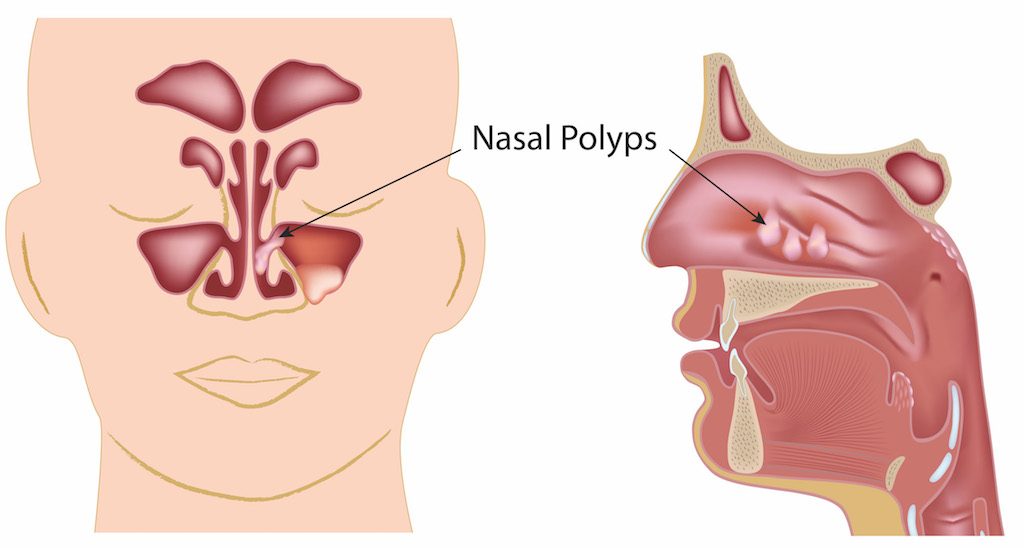An overview of Nasal Polyps
What are Nasal Polyps?
Nasal polyps are painless and benign (not cancerous) growths. They’re found in nasal passages and sinuses, hollow spaces in the bones around your nose. They form from mucous membranes — thin, soft tissue that lines these body parts.
Nasal polyps can get irritated and swollen, partially blocking the nasal passages and sinuses.

Who gets nasal polyps?
Nasal polyps don’t tend to develop until well into adulthood, when people are in their 30s or 40s.
They’re usually linked with some cause of inflammation in the nose, such as:
1. Asthma.
2. Allergic rhinitis (hay fever) or other allergies, such as to aspirin or fungus/fungi.
3. Chronic rhinosinusitis (CRS).
4. Cystic fibrosis.
6. Repeat sinus infections or other infections.
Causes of Nasal Polyps
Polyps develop because the mucous membranes lining the nose or sinuses change. The membranes become inflamed for a long time or become inflamed over and over again. The inflammation features swelling, redness and fluid buildup.
Researchers believe that allergies and infections cause the inflammation. They think that because they’ve studied tissue taken from nasal polyps. Those samples contained extra eosinophils, white blood cells linked to infections and allergic reactions. The evidence points to inflammation causing small growths filled with fluid. Those growths then turn into polyps.
Signs and symptoms of Nasal Polyps
Small polyps may not cause any symptoms. But as they grow, they may lead to:
1. Headaches.
2. Loss of smell or taste.
3. Nasal congestion (stuffy nose).
4. Nasal drainage (runny nose).
5. Nosebleeds.
6. Postnasal drip (constantly feeling like you have to clear your throat).
7. Pressure or pain in the sinuses, face or top teeth.
8. Snoring.
When polyps get big enough, they can block the nasal passages and sinuses, leading to:
1. Frequent asthma attacks in people with asthma.
2. Repeated sinus infections.
3. Sleep apnea or other trouble sleeping.
4. Trouble breathing, even in people who don’t have asthma.
Preventive measures against Nasal Polyps
Not everyone will be able to prevent nasal polyps. However, there are a few ways you may be able to help yourself. The strategies include the following:
1. Follow your doctor’s instructions on taking your allergy and asthma medications.
2. Avoid breathing airborne allergens or irritants that lead to inflammation of your nose and sinus cavities.
3. Practice good hygiene.
4. Use a humidifier in your home to help moisten your breathing passages.
5. Use a saline nasal rinse or spray to remove allergens or other irritants that may cause nasal polyps.
How are Nasal polyps Diagnosed?
If you have symptoms of nasal polyps, talk to a healthcare provider. To diagnose nasal polyps, the healthcare provider may:
1. Ask about your health history, especially allergies, infections and asthma.
2. Ask you about your symptoms and how long you’ve had them.
3. Look inside your nose with a nasal endoscope (thin, flexible tube with a tiny camera and light).
4. Order a CT scan to take detailed pictures inside your sinuses.
Treatment for Nasal Polyps
Not all patients can be cured of nasal polyps, but several treatments can help:
1. Steroid sprays to shrink polyps and improve symptoms.
2. Oral steroids (pills you swallow).
3. Injections (shots) under the skin to deliver a medicine called dupilumab.
4. Outpatient (no overnight stay) surgery to place a tiny stent. It props open the nasal passages and delivers steroids or other medications.
5 Outpatient surgery using endoscopy to remove polyps when other treatments don’t work.
Your healthcare provider also may prescribe antibiotics if you have an infection.
Complications
Beyond the common symptoms of nasal polyps, you may also be at risk for the following:
1. Facial pressure and swelling from sinus infections
2. Eye pain and swelling
3. Reduced vision
4. Severe headaches
5. Meningitis (rarely)
6. Nosebleeds
7. Voice problems and hoarseness
8. Frequent cough
9. Chronic bronchitis or other lower respiratory tract diseases
10. Sleep apnea
Frequently Asked Questions About Nasal Polyps
Nasal polyps usually appear on both sides. A growth on only one side may actually be something else, such as a cancerous tumor.
Polyps often come back after treatment. Many people need to stay on steroid treatments for a long time or have repeat surgery.
There is no definitive strategy to prevent Nasal Polyps. However, managing underlying medical conditions such as allergies or asthma may help reduce the likelihood of their occurrence. Minimising exposure to environmental triggers such as air pollution or cigarette smoke may provide further benefits.
Anyone can develop Nasal Polyps, but they are more common in adults over 40 and those with allergies, asthma or chronic sinus infections.